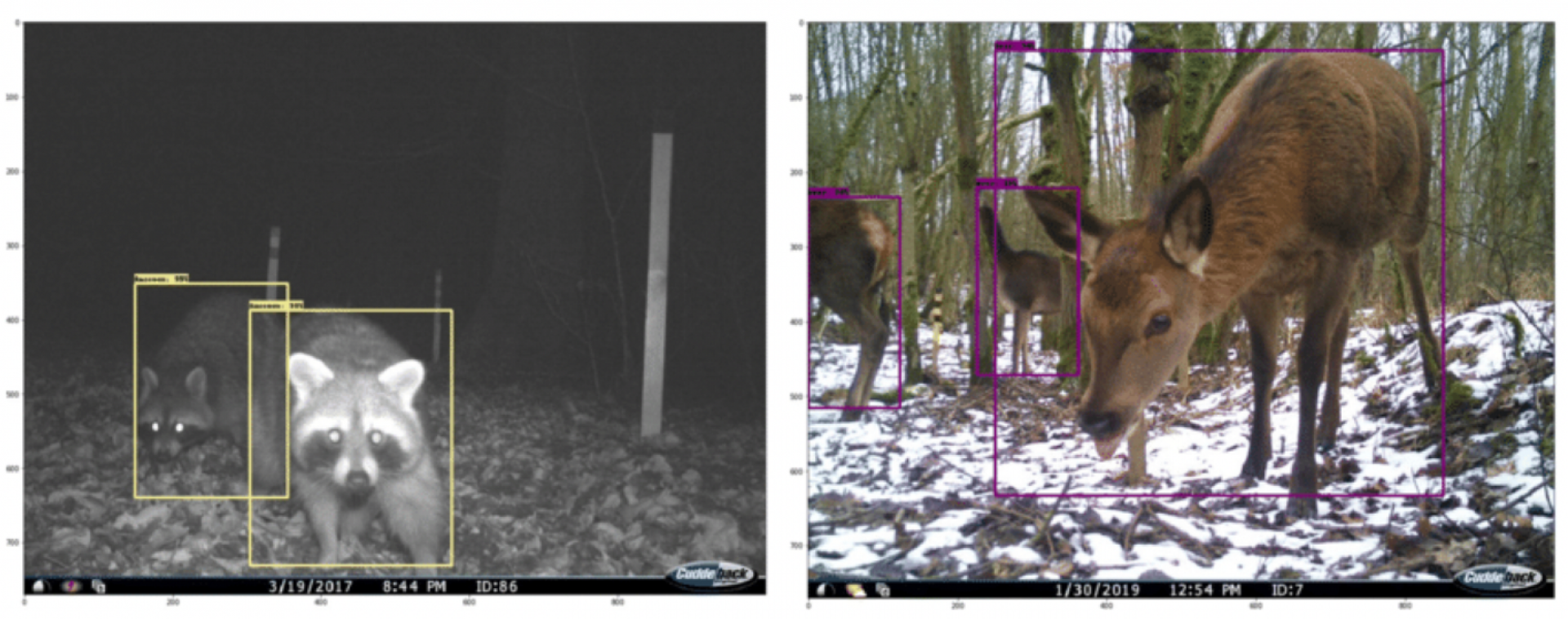Wildlife Conservation In The Age Of AI: Opportunities And Risks

Table of Contents
Opportunities of AI in Wildlife Conservation
AI offers a powerful toolkit for enhancing various aspects of wildlife conservation. Its applications range from improving monitoring and surveillance to predicting threats and optimizing anti-poaching strategies.
Enhanced Monitoring and Surveillance
AI-powered tools are revolutionizing how we monitor wildlife and their habitats. Drones equipped with advanced cameras and sensors can cover vast areas, capturing high-resolution images and videos. Camera traps, another key technology, are increasingly incorporating AI-powered image recognition, automatically identifying species and flagging events of interest, such as the presence of poachers.
- Automated image recognition: AI algorithms can rapidly analyze thousands of images, identifying specific species, individuals, and even behaviors.
- Real-time alerts: Systems can be set up to send immediate alerts to park rangers or conservationists when suspicious activity, such as poaching, is detected.
- Improved data analysis: AI algorithms can process vast datasets from multiple sources, providing comprehensive insights into animal populations, movement patterns, and habitat use.
- Reduced human intervention: AI-powered monitoring reduces the need for extensive human fieldwork in dangerous or remote areas.
For example, TensorFlow, a popular open-source machine learning framework, is being used to develop computer vision models capable of identifying endangered species from camera trap images with remarkable accuracy. Several successful projects leverage this technology for efficient and effective wildlife monitoring.
Predicting and Preventing Threats
Machine learning algorithms hold immense potential for predicting and mitigating various threats to wildlife. By analyzing environmental data, including satellite imagery, weather patterns, poaching incident reports, and historical data, AI models can identify areas at high risk of poaching, habitat loss, or disease outbreaks. This allows for proactive interventions, such as increased patrols or targeted conservation efforts.
- Predictive modeling: AI can forecast future threats based on historical trends and current conditions.
- Risk assessment: AI assists in identifying areas and species most vulnerable to specific threats.
- Early warning systems: AI-powered systems can provide timely alerts, enabling rapid response to emerging threats.
- Targeted conservation efforts: Predictive models help focus limited resources on the most effective conservation actions.
For instance, by analyzing satellite imagery and historical poaching data, AI models can pinpoint likely poaching hotspots, enabling rangers to strategically allocate resources and prevent illegal activities.
Improving Anti-Poaching Strategies
AI is proving invaluable in the fight against poaching. Facial recognition technology can identify poachers from surveillance footage, while AI-powered analysis of communication patterns can uncover poaching networks. Furthermore, AI can optimize patrol routes, maximizing ranger effectiveness and minimizing the risk of encounters with armed poachers.
- Real-time threat detection: AI can analyze data from various sources, such as drones, sensors, and communication intercepts, to identify potential threats in real time.
- Improved resource allocation: AI helps optimize the deployment of limited resources, ensuring that patrols are directed to areas with the highest risk of poaching.
- Enhanced law enforcement: AI-driven insights can provide crucial evidence for investigations and prosecutions.
- Collaborative networks: AI can facilitate the sharing of information and coordination among various stakeholders involved in anti-poaching efforts.
However, the use of facial recognition technology raises important ethical considerations, which must be carefully addressed. Transparency and strict data governance are essential to prevent misuse.
Protecting Endangered Species More Effectively
AI is transforming our understanding of endangered species and their habitats. By analyzing data on animal behavior, habitat suitability, and genetic diversity, AI-powered tools help develop personalized conservation plans that are more effective and efficient than traditional methods.
- Habitat suitability modeling: AI can identify areas most suitable for specific species, informing habitat restoration and protection efforts.
- Population estimation: AI-powered techniques offer more accurate estimates of endangered species populations.
- Genetic analysis: AI facilitates the analysis of genetic data, aiding in understanding population structure, genetic diversity, and inbreeding.
- Personalized conservation plans: AI helps tailor conservation strategies to the specific needs of individual species or populations.
Acoustic monitoring, for example, using AI to analyze animal vocalizations, provides insights into species distribution, population size, and even individual animal identification. This technology is particularly useful for species that are difficult to observe directly.
Risks and Challenges of AI in Wildlife Conservation
While AI offers tremendous opportunities, its integration into wildlife conservation also presents significant risks and challenges.
Data Bias and Algorithmic Limitations
AI models are trained on data, and biased or incomplete data can lead to flawed predictions and ineffective conservation strategies. The lack of transparency in some AI algorithms ("black box" algorithms) makes it difficult to understand how decisions are made, potentially hindering trust and accountability.
- Data quality issues: Incomplete, inaccurate, or biased data can lead to unreliable predictions.
- Algorithm bias: AI models can perpetuate existing biases present in the data they are trained on.
- Lack of transparency: The decision-making process of some AI algorithms can be opaque, making it difficult to understand their outputs.
- Potential for misinterpretation: Incorrect interpretations of AI-generated predictions can lead to ineffective or even harmful conservation actions.
It is crucial to ensure that the data used to train AI models is diverse, representative, and of high quality. Research into "explainable AI" (XAI) aims to address the issue of black box algorithms, making their decision-making processes more transparent and understandable.
Technological Dependence and Infrastructure Limitations
The reliance on technology brings vulnerabilities. Power outages, internet connectivity issues, equipment malfunctions, and lack of maintenance can severely hinder AI-powered conservation efforts, particularly in remote areas.
- Power requirements: AI systems often require significant power, posing a challenge in remote locations with limited access to electricity.
- Internet connectivity: Many AI applications rely on internet connectivity, which can be unreliable or unavailable in many conservation areas.
- Equipment maintenance: The regular maintenance and repair of AI equipment are essential for reliable operation, but this can be difficult in remote areas.
- Technological failures: Malfunctions or failures of AI systems can have significant consequences for conservation efforts.
Deploying AI in remote and resource-constrained environments requires careful planning, robust infrastructure, and contingency plans to address potential technological failures.
Ethical Concerns and Privacy Issues
The use of AI in wildlife conservation raises ethical concerns regarding surveillance, data privacy, and the potential for misuse of technology.
- Data security: Protecting sensitive data from unauthorized access and breaches is crucial.
- Informed consent: Obtaining informed consent for data collection and use, especially when involving human communities, is essential.
- Potential for misuse: AI technology could be misused for purposes that are detrimental to wildlife or human communities.
- Transparency and accountability: Transparency in data collection, algorithm development, and decision-making processes is crucial for building trust and accountability.
It's vital to establish clear ethical guidelines and regulations for the use of AI in wildlife conservation, ensuring that it is used responsibly and ethically, respecting the rights and well-being of both wildlife and human communities. Careful consideration must be given to the potential for displacement of local communities.
Conclusion
AI offers transformative potential for wildlife conservation, enabling more efficient monitoring, predictive modeling, and targeted interventions. However, addressing data bias, technological limitations, and ethical concerns is crucial for responsible implementation. By carefully considering both opportunities and risks, we can harness the power of AI to significantly improve wildlife conservation efforts and secure a future for endangered species. Let's embrace the innovative applications of AI in wildlife conservation while mitigating its potential downsides, working towards a sustainable future for all. Let's work together to leverage the power of AI in wildlife conservation, ensuring its responsible and ethical application for the benefit of all.

Featured Posts
-
 Increased Tariffs Walmart And Target Executives Meet With President Trump
Apr 23, 2025
Increased Tariffs Walmart And Target Executives Meet With President Trump
Apr 23, 2025 -
 Resultats Fdj Du 17 Fevrier Hausse En Bourse
Apr 23, 2025
Resultats Fdj Du 17 Fevrier Hausse En Bourse
Apr 23, 2025 -
 Byan Asear Alktakyt Fy Msr Alathnyn 14 Abryl 2025
Apr 23, 2025
Byan Asear Alktakyt Fy Msr Alathnyn 14 Abryl 2025
Apr 23, 2025 -
 Roberts On World Series A Single Hit Changed Everything
Apr 23, 2025
Roberts On World Series A Single Hit Changed Everything
Apr 23, 2025 -
 Pierre Poilievres Fall From 20 Point Lead To Defeat
Apr 23, 2025
Pierre Poilievres Fall From 20 Point Lead To Defeat
Apr 23, 2025
